Navigation
Install the app
How to install the app on iOS
Follow along with the video below to see how to install our site as a web app on your home screen.
Note: This feature may not be available in some browsers.
More options
You are using an out of date browser. It may not display this or other websites correctly.
You should upgrade or use an alternative browser.
You should upgrade or use an alternative browser.
The Dornier is lifted at last
- Thread starter Readie
- Start date
Ad: This forum contains affiliate links to products on Amazon and eBay. More information in Terms and rules
More options
Who Replied?yulzari
Staff Sergeant
I understand the IWM intend to display it as a preserved wreck rather than as a restored aeroplane. To be ultimately displayed together with the Hurricane it displays as a preserved wreck. The Bulgarians were still using them against the Germans in 1945!
Maximowitz
Tech Sergeant
On a different note, two of the crew perished. With all of the admin hurdles the MoD imposes over war graves, how was this overcome?
The two bodies were washed ashore some days after the crash.
Yes, agree Terry, Bl**dy Beacon!
The decision not to restore the Halifax was based on a few different factors. The biggest being the effort at the time was deemed beyond the resources of the museum. Remember, Hendon opened in 1971; the Halifax was hauled up from the Norwegian fiord in 1973. It didn't arrive at Hendon until 1982, being in store at Henlow between times; Henlow was the RAFM store for a bit and was even earmarked as a possible site for the RAF Museum in the late '60s. A few items were restored, including the nose turret and one of its engines, the latter by the Medway Aircraft Preservation Society. The restored turret was used as a fund raiser at events for the Bomber Command Hall, where it's now located.
Yulzari, the aircraft is going to the RAF Museum, not the Imperial War Museum (IWM).
On the subject of the fallen crewmembers:
The Museum pays its respects | Blog | RAF Museum
Personally I see the Halifax as a badly wasted opportunity
The decision not to restore the Halifax was based on a few different factors. The biggest being the effort at the time was deemed beyond the resources of the museum. Remember, Hendon opened in 1971; the Halifax was hauled up from the Norwegian fiord in 1973. It didn't arrive at Hendon until 1982, being in store at Henlow between times; Henlow was the RAFM store for a bit and was even earmarked as a possible site for the RAF Museum in the late '60s. A few items were restored, including the nose turret and one of its engines, the latter by the Medway Aircraft Preservation Society. The restored turret was used as a fund raiser at events for the Bomber Command Hall, where it's now located.
Yulzari, the aircraft is going to the RAF Museum, not the Imperial War Museum (IWM).
On the subject of the fallen crewmembers:
The Museum pays its respects | Blog | RAF Museum
Good to see that the Do17 came out relatively intact and that it is to be preserved as is.
According to The Battle of Britain:Then and Now, Vol V it was a Do17, Wnr. 1160, 5K+AR of 7./KG 2; Shot down by fighters, force landed Goodwin Sands 11:40am. August 26. Gefr. Huhn killed; Uffz Ritzel missing: Fw Essbert captured wounded and Uffz Reinhardt captured. According to The Blitz:Then and Now, Vol One it had been on a sortie to bomb West Malling and had both engines shot out by fighters.
According to The Battle of Britain:Then and Now, Vol V it was a Do17, Wnr. 1160, 5K+AR of 7./KG 2; Shot down by fighters, force landed Goodwin Sands 11:40am. August 26. Gefr. Huhn killed; Uffz Ritzel missing: Fw Essbert captured wounded and Uffz Reinhardt captured. According to The Blitz:Then and Now, Vol One it had been on a sortie to bomb West Malling and had both engines shot out by fighters.
The plan is conservation - which is best in my view. It is a wonderful relic from the Battle that effectively kept the UK from the Nazi tyranny. A restoration would be wrong. That said, it would be nice if they could graft in missing parts or indeed a space frame skeleton to define missing items. The RAFM are good at this. The conservation started with washing and a gel to try to keep oxidisation at bay during the transport and dismantling phase. She will go into poly tunnel baths Terry posted and have citric acid flushing probably for around 18 months. They will no doubt need some kind of coating at the end.
The remains of Maffetts Hurricane in the BoB Museum are so moving. Especially withe the roll of honour and Elgar's Nimrod playing. Something similar for the Do17 would be fitting. The German crews were brave and not all Nazis.
The remains of Maffetts Hurricane in the BoB Museum are so moving. Especially withe the roll of honour and Elgar's Nimrod playing. Something similar for the Do17 would be fitting. The German crews were brave and not all Nazis.
According to The Battle of Britain:Then and Now, Vol V it was a Do17, Wnr. 1160, 5K+AR of 7./KG 2; Shot down by fighters, force landed Goodwin Sands 11:40am. August 26. Gefr. Huhn killed; Uffz Ritzel missing: Fw Essbert captured wounded and Uffz Reinhardt captured. According to The Blitz:Then and Now, Vol One it had been on a sortie to bomb West Malling and had both engines shot out by fighters.
Shot down by Defiants of 264 Sqn, possibly Flt Lt A.J. Banham in L6985, who was also shot down by Bf 109s. The raid comprised 12 Do 17s, 40 He 111s being escorted by some 80 Bf 109s and Bf 110s, which were attacked by around 70 Hurricanes and Spitfires, accompanied by 6 (or more) Defiants (!). The Hurris and Spits took off after the Heinkels and left the Dorniers to the Defiants. 264 Sqn's tally was six Do 17s and a Bf 109 claimed. Actual losses was four Dorniers and a Bf 109 to 264 Sqn, for the loss of three Defiants.
Airframes
Benevolens Magister
In that photo, the engines are still on the sea bed, only the empty nacelles are showing, so a tad difficult to say that an engine was running. The separate prop in front of the port engine (the aircraft is on its back) shows damage concurrent with a stopped or windmilling engine, with the blades bent to the rear - if it had been under power, the blades would bend forward. It's possible the other engine might still have been running though.Looks like at least one engine was running. The part of the wing root not covered in barnicles looks like its in really good shape.

Last edited:
I'm a bit confused here, That's the gear reduction facing up, correct? Every pic I ever seen with the engine under power and the plane crash landing on land or water, the prop blades were always bent back, like in the pic above. Wind milling too, albeit just one or two blades bent back, depending on the speed of rotation.
Njaco
The Pop-Tart Whisperer
Its lying on its back.
- Thread starter
- #32
Readie
Chief Master Sergeant
Its lying on its back.
I wonder what else lays on the Goodwin sands awaiting discovery?
Airframes
Benevolens Magister
No. If an engine is stopped, or throttled right back, and with lack of power, the prop blades offer little resistance when they strike, and will bend backwards, even if apparently turning relatively fast. Depending on the angle of strike, and how quickly the prop comes to a sudden stop, it's possible for one, two or all three blades (on a 3 blade metal prop) to be bent.I'm a bit confused here, That's the gear reduction facing up, correct? Every pic I ever seen with the engine under power and the plane crash landing on land or water, the prop blades were always bent back, like in the pic above. Wind milling too, albeit just one or two blades bent back, depending on the speed of rotation.
However, if the engine is under power, the blades are not turning freely, and will continue to try to rotate until the force of contact overcomes the force of the crank and the engine seizes, again dependent, at least to some extent, on the angle of contact, and will therefore bend forwards.
It's highly likely that the starboard engine, when recovered, might exhibit evidence that this was still running, although perhaps losing power, allowing a controlled ditching, although, of course, until the engines are recovered, or the Intelligence (Air) interrogation reports include the information, we won't know if the aircraft retained power to one engine, or lost power totally, resulting in a glide approach and ditching.
Its thrown up an obstacle already....
https://www.facebook.com/media/set/?set=a.10151406440136533.1073741830.19869991532&type=1
https://www.facebook.com/media/set/?set=a.10151406440136533.1073741830.19869991532&type=1
Airframes
Benevolens Magister
Not really an obstacle - it would have been (or should have been) anticipated. There are possibly a lot more hazards for those handling the remains, in the way of dangerous or toxic substances due to corrosion and chemical change after submersion for so long.
buffnut453
Captain
Thought everyone might like to see this unusual top view of the Dornier on the barge courtesy of the BBC's website.
I'm seeing 2 engines and at least one prop behind the port wing which, itself, is rather more complete than I, for one, first believed. The starboard wing is pretty much non-existent outboard of the engine and the fuselage looks to be disconnected from the forward fuselage (the whole rear fuselage seemed rather wobbly on the video of the aircraft recovery - then again, it was called the "Flying Pencil").

I'm seeing 2 engines and at least one prop behind the port wing which, itself, is rather more complete than I, for one, first believed. The starboard wing is pretty much non-existent outboard of the engine and the fuselage looks to be disconnected from the forward fuselage (the whole rear fuselage seemed rather wobbly on the video of the aircraft recovery - then again, it was called the "Flying Pencil").
Airframes
Benevolens Magister
UP-Date, July 2013.
As we all know, the Dornier Do17 was successfully raised from the sea bed on the Goodwin Sands, 8 miles off the coast in the English Channel, on June 9th.
Further information provided by the recovery team, and the RAF Museum, Cosford, gives some insight into the difficulties of this undertaking, and also provides a little glimpse into the last moments of flight of the aircraft, during it's attempted escape during the Battle of Britain, before ditching and sinking inverted.
Work on the lift recommenced following sever storms and heavy seas, but the dive team were astonished to find that the strong currents had moved the aircraft more than 100 meters, and it now lay not on sand, but on a bed of chalk rock. This prevented the use of the specially designed and built lifting frame, which could no longer be slid beneath the delicate airframe.
Instead, a cruciform lifting beam was employed, to spread the weight of aircraft and water, and the lifting cables were attached to the main spar, access to which was gained via the open bomb bay, through the inverted fuselage of the Dornier.
Once the aircraft had been safely lowered onto the recovery barge, work began to remove the wings, and again the team were surprised, and delighted, to find that, once marine detritus had been carefully cleaned away, the wing retaining bolts, still greased, turned easily and effortlessly, allowing ease of removal without excessive force, which in turn allowed the removal of the wings without causing damage to the structure.
It was also discovered that all of the 7.92mm ammunition, from all of the defensive MG15's had been fired - all of the 'saddle' magazines were empty, indicating that the bomber had returned fire up to the last moment.
The Dornier was then transported by road to the RAF Museum Conservation center at RAF Cosford, near Wolverhampton, where it was placed in the two specially prepared 'polly tunnel' hydration plants, where it will remain for at least two years, whilst the airframe is stabilised, and further corrosion inhibited, by regularly timed sprays of saline solution, citric acid solution and, eventually, fresh water, when work will then commence on removing the barnacles and other marine growth, before conservation and preservation begins in earnest.
Having been shown the 'polly tunnels' during a visit last year, I was able to now view the Dornier in situ, when i was once again at Cosford over the weekend, for the Large Model Aircraft Rally, and here are the photos.
The condensation and polythene walls of the tents are not conducive to good photography, and of course the tunnels are sealed to reduce the amount of air coming into contact with the remains, but it can be seen, and it was a moving experience to see at first hand this sole survivor, after 73 years on the sea bed.
The photos show the entrance to the poly tunnel, situated between two of Cosford's hangars, with the wing and its internal structure, an engine nacelle complete with landing gear wheel and tyre, where the maker's badge can still be seen on the hub, as well as the still inverted fuselage at the cockpit area, plus some loose components.
As we all know, the Dornier Do17 was successfully raised from the sea bed on the Goodwin Sands, 8 miles off the coast in the English Channel, on June 9th.
Further information provided by the recovery team, and the RAF Museum, Cosford, gives some insight into the difficulties of this undertaking, and also provides a little glimpse into the last moments of flight of the aircraft, during it's attempted escape during the Battle of Britain, before ditching and sinking inverted.
Work on the lift recommenced following sever storms and heavy seas, but the dive team were astonished to find that the strong currents had moved the aircraft more than 100 meters, and it now lay not on sand, but on a bed of chalk rock. This prevented the use of the specially designed and built lifting frame, which could no longer be slid beneath the delicate airframe.
Instead, a cruciform lifting beam was employed, to spread the weight of aircraft and water, and the lifting cables were attached to the main spar, access to which was gained via the open bomb bay, through the inverted fuselage of the Dornier.
Once the aircraft had been safely lowered onto the recovery barge, work began to remove the wings, and again the team were surprised, and delighted, to find that, once marine detritus had been carefully cleaned away, the wing retaining bolts, still greased, turned easily and effortlessly, allowing ease of removal without excessive force, which in turn allowed the removal of the wings without causing damage to the structure.
It was also discovered that all of the 7.92mm ammunition, from all of the defensive MG15's had been fired - all of the 'saddle' magazines were empty, indicating that the bomber had returned fire up to the last moment.
The Dornier was then transported by road to the RAF Museum Conservation center at RAF Cosford, near Wolverhampton, where it was placed in the two specially prepared 'polly tunnel' hydration plants, where it will remain for at least two years, whilst the airframe is stabilised, and further corrosion inhibited, by regularly timed sprays of saline solution, citric acid solution and, eventually, fresh water, when work will then commence on removing the barnacles and other marine growth, before conservation and preservation begins in earnest.
Having been shown the 'polly tunnels' during a visit last year, I was able to now view the Dornier in situ, when i was once again at Cosford over the weekend, for the Large Model Aircraft Rally, and here are the photos.
The condensation and polythene walls of the tents are not conducive to good photography, and of course the tunnels are sealed to reduce the amount of air coming into contact with the remains, but it can be seen, and it was a moving experience to see at first hand this sole survivor, after 73 years on the sea bed.
The photos show the entrance to the poly tunnel, situated between two of Cosford's hangars, with the wing and its internal structure, an engine nacelle complete with landing gear wheel and tyre, where the maker's badge can still be seen on the hub, as well as the still inverted fuselage at the cockpit area, plus some loose components.
Attachments
-
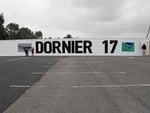 Cosfd Model 2013 490.jpg103.4 KB · Views: 131
Cosfd Model 2013 490.jpg103.4 KB · Views: 131 -
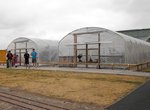 Cosfd Model 2013 477.jpg100.5 KB · Views: 132
Cosfd Model 2013 477.jpg100.5 KB · Views: 132 -
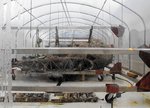 Cosfd Model 2013 478.jpg100.9 KB · Views: 132
Cosfd Model 2013 478.jpg100.9 KB · Views: 132 -
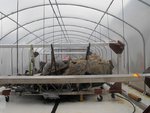 Cosfd Model 2013 479.jpg97.8 KB · Views: 145
Cosfd Model 2013 479.jpg97.8 KB · Views: 145 -
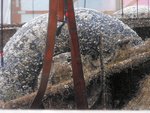 Cosfd Model 2013 480.jpg160.4 KB · Views: 108
Cosfd Model 2013 480.jpg160.4 KB · Views: 108 -
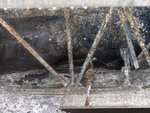 Cosfd Model 2013 481.jpg137.5 KB · Views: 124
Cosfd Model 2013 481.jpg137.5 KB · Views: 124 -
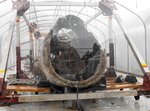 Cosfd Model 2013 482.jpg103.1 KB · Views: 127
Cosfd Model 2013 482.jpg103.1 KB · Views: 127 -
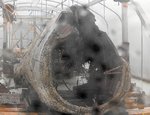 Cosfd Model 2013 483.jpg136.1 KB · Views: 129
Cosfd Model 2013 483.jpg136.1 KB · Views: 129 -
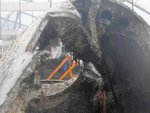 Cosfd Model 2013 484.jpg124.8 KB · Views: 129
Cosfd Model 2013 484.jpg124.8 KB · Views: 129 -
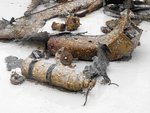 Cosfd Model 2013 485.jpg135.4 KB · Views: 127
Cosfd Model 2013 485.jpg135.4 KB · Views: 127
GrauGeist
Generalfeldmarschall zur Luftschiff Abteilung
Great update, Terry!
Do you know if they are going just stabilize it and display it in it's current condition, or will they attempt to restore it to pre-wreck condition?
The other question that comes to mind, is did they search the area around the crash site to see if there were any other articles that may have come to rest outside of the aircraft (side arms, ammo boxes, loose equipment, etc)?
Do you know if they are going just stabilize it and display it in it's current condition, or will they attempt to restore it to pre-wreck condition?
The other question that comes to mind, is did they search the area around the crash site to see if there were any other articles that may have come to rest outside of the aircraft (side arms, ammo boxes, loose equipment, etc)?
Crimea_River
Marshal
Excellent info Terry and thanks for keeping us up to date.
Airframes
Benevolens Magister
You're welcome chaps.
David, the intention is to conserve rather than preserve, and as far as is known to date, the aircraft will be stabilised, cleaned and inhibited to prevent further corrosion, before it is then put on display in a clean, possibly partly re-built, but otherwise 'as found' condition. In other words, it will be recognisable as a Do17, I presume the right way up, and will be a similar display as the Halifax at Hendon, recovered from lake Hocklingen, Norway, in 1973.
I'll post further up-dates as and when information is received.
David, the intention is to conserve rather than preserve, and as far as is known to date, the aircraft will be stabilised, cleaned and inhibited to prevent further corrosion, before it is then put on display in a clean, possibly partly re-built, but otherwise 'as found' condition. In other words, it will be recognisable as a Do17, I presume the right way up, and will be a similar display as the Halifax at Hendon, recovered from lake Hocklingen, Norway, in 1973.
I'll post further up-dates as and when information is received.
Users who are viewing this thread
Total: 1 (members: 0, guests: 1)
Similar threads
- Replies
- 134
- Views
- 10K
